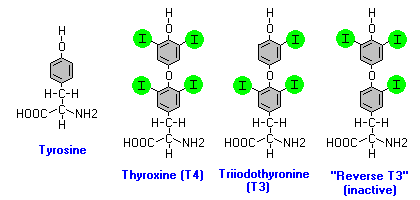VIVO Pathophysiology
Chemistry of Thyroid Hormones
Thyroid hormones are derivatives of the the amino acid tyrosine bound covalently to iodine. The two principal thyroid hormones are:
- thyroxine (also known as T4 or L-3,5,3',5'-tetraiodothyronine)
- triiodothyronine (T3 or L-3,5,3'-triiodothyronine)
As shown in the following diagram, the thyroid hormones are basically two tyrosines linked together with the critical addition of iodine at three or four positions on the aromatic rings. The number and position of the iodines is important. Several other iodinated molecules are generated that have little or no biological activity; so called "reverse T3" (3,3',5'-T3) is such an example.

A large majority of the thyroid hormone secreted from the thyroid gland is T4, but T3 is the considerably more active hormone. Although some T3 is also secreted, the bulk of the T3 is derived by deiodination of T4 in peripheral tissues, especially liver and kidney. Deiodination of T4 also yields reverse T3, a molecule with no known metabolic activity.
Thyroid hormones are poorly soluble in water, and more than 99% of the T3 and T4 circulating in blood is bound to carrier proteins. The principle carrier of thyroid hormones is thyroxine-binding globulin, a glycoprotein synthesized in the liver. Two other carriers of import are transthyretin and albumin. Carrier proteins allow maintenance of a stable pool of thyroid hormones from which the active, free hormones are released for uptake by target cells.
Updated October 2021. Send comments to Richard.Bowen@colostate.edu

